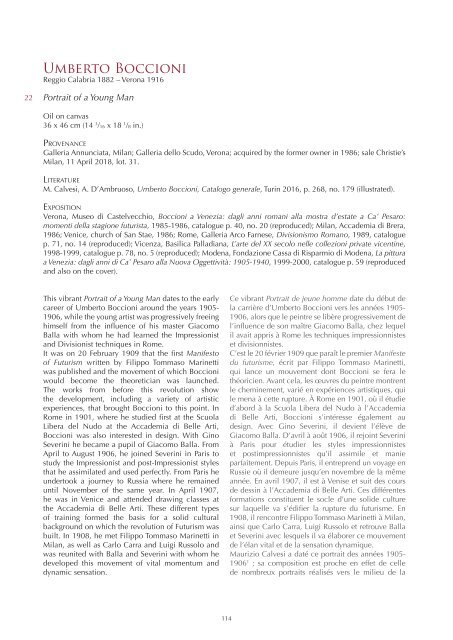XVII - Master Paintings - Jean Luc Baroni and Marty de Cambiaire
You also want an ePaper? Increase the reach of your titles
YUMPU automatically turns print PDFs into web optimized ePapers that Google loves.
Umberto Boccioni<br />
Reggio Calabria 1882 – Verona 1916<br />
22<br />
Portrait of a Young Man<br />
Oil on canvas<br />
36 x 46 cm (14 3 /16 x 18 1 /8 in.)<br />
Provenance<br />
Galleria Annunciata, Milan; Galleria <strong>de</strong>llo Scudo, Verona; acquired by the former owner in 1986; sale Christie’s<br />
Milan, 11 April 2018, lot. 31.<br />
Literature<br />
M. Calvesi, A. D’Ambruoso, Umberto Boccioni, Catalogo generale, Turin 2016, p. 268, no. 179 (illustrated).<br />
Exposition<br />
Verona, Museo di Castelvecchio, Boccioni a Venezia: dagli anni romani alla mostra d’estate a Ca’ Pesaro:<br />
momenti <strong>de</strong>lla stagione futurista, 1985-1986, catalogue p. 40, no. 20 (reproduced); Milan, Acca<strong>de</strong>mia di Brera,<br />
1986; Venice, church of San Stae, 1986; Rome, Galleria Arco Farnese, Divisionismo Romano, 1989, catalogue<br />
p. 71, no. 14 (reproduced); Vicenza, Basilica Palladiana, L’arte <strong>de</strong>l XX secolo nelle collezioni private vicentine,<br />
1998-1999, catalogue p. 78, no. 5 (reproduced); Mo<strong>de</strong>na, Fondazione Cassa di Risparmio di Mo<strong>de</strong>na, La pittura<br />
a Venezia: dagli anni di Ca’ Pesaro alla Nuova Oggettività: 1905-1940, 1999-2000, catalogue p. 59 (reproduced<br />
<strong>and</strong> also on the cover).<br />
This vibrant Portrait of a Young Man dates to the early<br />
career of Umberto Boccioni around the years 1905-<br />
1906, while the young artist was progressively freeing<br />
himself from the influence of his master Giacomo<br />
Balla with whom he had learned the Impressionist<br />
<strong>and</strong> Divisionist techniques in Rome.<br />
It was on 20 February 1909 that the first Manifesto<br />
of Futurism written by Filippo Tommaso Marinetti<br />
was published <strong>and</strong> the movement of which Boccioni<br />
would become the theoretician was launched.<br />
The works from before this revolution show<br />
the <strong>de</strong>velopment, including a variety of artistic<br />
experiences, that brought Boccioni to this point. In<br />
Rome in 1901, where he studied first at the Scuola<br />
Libera <strong>de</strong>l Nudo at the Acca<strong>de</strong>mia di Belle Arti,<br />
Boccioni was also interested in <strong>de</strong>sign. With Gino<br />
Severini he became a pupil of Giacomo Balla. From<br />
April to August 1906, he joined Severini in Paris to<br />
study the Impressionist <strong>and</strong> post-Impressionist styles<br />
that he assimilated <strong>and</strong> used perfectly. From Paris he<br />
un<strong>de</strong>rtook a journey to Russia where he remained<br />
until November of the same year. In April 1907,<br />
he was in Venice <strong>and</strong> atten<strong>de</strong>d drawing classes at<br />
the Acca<strong>de</strong>mia di Belle Arti. These different types<br />
of training formed the basis for a solid cultural<br />
background on which the revolution of Futurism was<br />
built. In 1908, he met Filippo Tommaso Marinetti in<br />
Milan, as well as Carlo Carra <strong>and</strong> Luigi Russolo <strong>and</strong><br />
was reunited with Balla <strong>and</strong> Severini with whom he<br />
<strong>de</strong>veloped this movement of vital momentum <strong>and</strong><br />
dynamic sensation.<br />
Ce vibrant Portrait <strong>de</strong> jeune homme date du début <strong>de</strong><br />
la carrière d’Umberto Boccioni vers les années 1905-<br />
1906, alors que le peintre se libère progressivement <strong>de</strong><br />
l’influence <strong>de</strong> son maître Giacomo Balla, chez lequel<br />
il avait appris à Rome les techniques impressionnistes<br />
et divisionnistes.<br />
C’est le 20 février 1909 que paraît le premier Manifeste<br />
du futurisme, écrit par Filippo Tommaso Marinetti,<br />
qui lance un mouvement dont Boccioni se fera le<br />
théoricien. Avant cela, les œuvres du peintre montrent<br />
le cheminement, varié en expériences artistiques, qui<br />
le mena à cette rupture. À Rome en 1901, où il étudie<br />
d’abord à la Scuola Libera <strong>de</strong>l Nudo à l’Acca<strong>de</strong>mia<br />
di Belle Arti, Boccioni s’intéresse également au<br />
<strong>de</strong>sign. Avec Gino Severini, il <strong>de</strong>vient l’élève <strong>de</strong><br />
Giacomo Balla. D’avril à août 1906, il rejoint Severini<br />
à Paris pour étudier les styles impressionnistes<br />
et postimpressionnistes qu’il assimile et manie<br />
parfaitement. Depuis Paris, il entreprend un voyage en<br />
Russie où il <strong>de</strong>meure jusqu’en novembre <strong>de</strong> la même<br />
année. En avril 1907, il est à Venise et suit <strong>de</strong>s cours<br />
<strong>de</strong> <strong>de</strong>ssin à l’Acca<strong>de</strong>mia di Belle Arti. Ces différentes<br />
formations constituent le socle d’une soli<strong>de</strong> culture<br />
sur laquelle va s’édifier la rupture du futurisme. En<br />
1908, il rencontre Filippo Tommaso Marinetti à Milan,<br />
ainsi que Carlo Carra, Luigi Russolo et retrouve Balla<br />
et Severini avec lesquels il va élaborer ce mouvement<br />
<strong>de</strong> l’élan vital et <strong>de</strong> la sensation dynamique.<br />
Maurizio Calvesi a daté ce portrait <strong>de</strong>s années 1905-<br />
1906 1 ; sa composition est proche en effet <strong>de</strong> celle<br />
<strong>de</strong> nombreux portraits réalisés vers le milieu <strong>de</strong> la<br />
114















